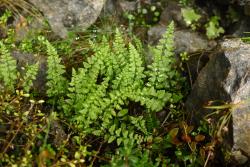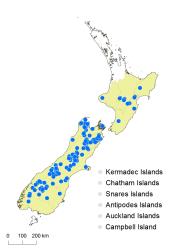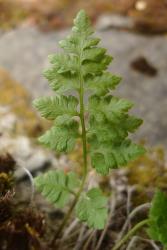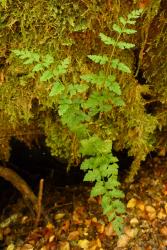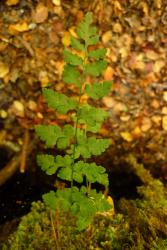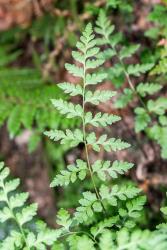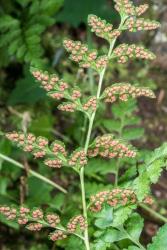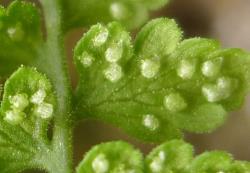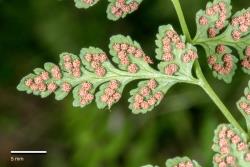- ≡ Cystopteris fragilis var. tasmanica (Hook.) Hook.f., Bot. Antarct. Voy. III. (Fl. Tasman.) Part II, 136, t. 166 (1858)
- = Cystopteris novae-zealandiae J.B.Armstr., Trans. & Proc. New Zealand Inst. 13: 360 (1881)
Rhizomes short-creeping, up to 60 mm long (in herbarium specimens), 1.5–3 mm in diameter, with stipes arising 2–10 mm apart; bearing scales. Rhizome scales narrowly ovate, 2.5–4 mm long, 0.3–1.0 mm wide, golden brown. Fronds 25–400 mm long, or rarely to 470 mm long. Stipes 10–225 mm long, rarely to 250 mm long, pale brown to yellow-brown or rarely red-brown proximally, bearing scattered narrowly ovate pale brown scales with filiform apices, up to 4 mm long, 0.5 mm wide. Rachises pale brown, becoming green distally, narrowly winged distally, sulcate, bearing scattered hair-like scales up to 1 mm long. Laminae 1–2-pinnate or rarely 1–2-pinnate-pinnatifid, ovate or narrowly ovate or narrowly elliptic, tapering to a pinnatifid apex, 18–245 mm long, 5–75 mm or rarely to 88 mm wide, yellow-green on both surfaces, herbaceous; mature fronds glabrous or with a few scattered hair-like scales on costae, young fronds sometimes abundantly covered in minute glandular hairs (apparently lost with age and with drying). Primary pinnae in 4–14 pairs, widely spaced, winged throughout, ovate to oblong; the longest at or below the middle, short-stalked, 3–45 mm long, 3–24 mm wide, apices acute or obtuse or rounded; those on pinnate fronds divided into rounded lobes, those on more divided fronds partly or completely divided into secondary pinnae. Secondary pinnae decreasing slightly in length along each primary pinna to the distal end; the longest secondary pinnae elliptic or ovate, 2–13 mm long, 1–11 mm wide, apices obtuse or rounded, margins crenate to deeply divided, bases shortly stalked or adnate. Sori round, on veins; indusia ovate to broadly ovate, 0.6–1 mm long.
Cystopteris tasmanica is an indigenous species, largely confined to limestone in montane to alpine areas. It is distinguished morphologically from the naturalised C. fragilis by its generally smaller and less divided laminae (1–2-pinnate cf. 2–3-pinnate), by its shorter and narrower primary pinnae (6–42 mm long, 4–24 mm wide cf. 16–95 mm long, 9–50 mm wide), and by the apices of its primary and secondary pinnae, which are obtuse or rounded rather than acute to acuminate.
North Island: Volcanic Plateau, Gisborne, Taranaki, Southern North Island.
South Island: Western Nelson, Sounds-Nelson, Marlborough, Westland, Canterbury, Otago, Fiordland, Southland.
Altitudinal range: 300–1900 m.
Cystopteris tasmanica is an uncommon plant in the North Island, being found from 1000–1900 m on Mt Taranaki, Mt Ruapehu, and from the Gisborne to Tararua Ranges. In the South Island it occurs in montane to alpine areas in north-west Nelson and along, and to the east of, the main divide. It ranges from 300 m in the Rakaia Gorge to over 1750 m on Mt Owen in north-west Nelson.
Also Australia (New South Wales, Victoria, Tasmania).
Cystopteris tasmanica grows most frequently on limestone or marble, but sometimes also on greywacke and granite. It occurs under rocks and boulders, in sink-holes, in rock crevices and on wet rock faces, in caves, on stable scree, and on track and river banks, either in shaded rocky areas, subalpine grassland or under scrub, beech or podocarp forest.
n = 84 (Brownlie 1958, as Cystopteris fragilis).
New Zealand plants were misidentified as the European C. fragilis in most earlier New Zealand Floras (e.g. Hooker 1867; Cheeseman 1906, 1925; Allan 1961; Crookes 1963). They were referred to the South American C. fragilis var. apiiformis (Gand.) C.Chr. by Blasdell (1963). Whether or not Australasian material is identical to South American material remains to be determined, but in any event the name C. tasmanica (at species or varietal rank) has priority.
Blasdell (1963) noted that minute glandular hairs are present on fronds of several species of Cystopteris. They have occasionally been observed on young living fronds of C. tasmanica, but they are apparently lost with maturity, and with drying, and have not been observed on herbarium material.



